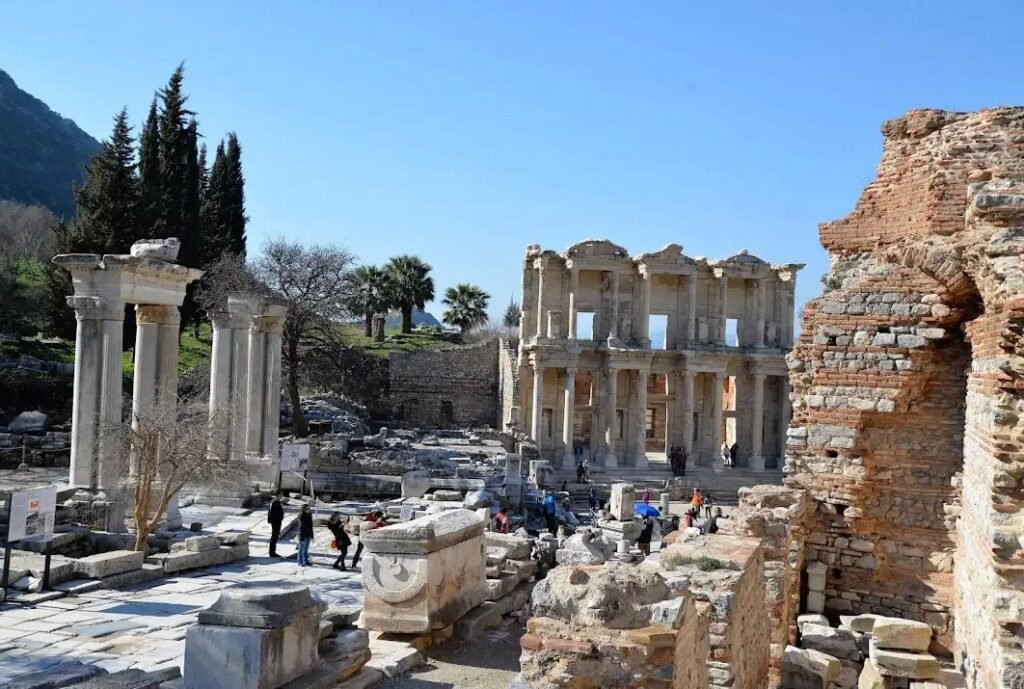Description
The Library of Celsus: A Timeless Gem of Selçuk, İzmir
The Library of Celsus stands as one of the most iconic and remarkable structures in Turkey, captivating the hearts of visitors with its grandeur, history, and architectural brilliance. Nestled in the ancient city of Ephesus, near the modern town of Selçuk in the İzmir province, this historic treasure offers a glimpse into the intellectual and cultural life of the Roman Empire. With its fascinating backstory, stunning design, and enduring legacy, the Library of Celsus remains an unmissable destination for history enthusiasts and travelers alike.
Historical Background
Built in the early 2nd century AD, the Library of Celsus was commissioned by Gaius Julius Aquila in honor of his father, Tiberius Julius Celsus Polemaeanus, a Roman senator and governor of Asia. Unlike many other libraries of the ancient world, the Library of Celsus served not only as a repository of knowledge but also as a monumental tomb for Celsus, whose sarcophagus was placed in a crypt beneath the building. This dual purpose made it a unique structure, blending intellectual pursuits with reverence for the deceased.
The library was constructed during the height of Ephesus’ prominence as a major urban and cultural center in the Roman Empire. Housing an estimated 12,000 scrolls, it was one of the largest libraries of the ancient world, rivaling those in Alexandria and Pergamum. It symbolized the city’s dedication to learning and the arts, reflecting the broader Roman ideals of civic pride and cultural achievement.
Architectural Splendor
The Library of Celsus is celebrated for its stunning façade, a masterpiece of Roman architecture. Designed in the classical style, the two-story structure is adorned with intricate details, including Corinthian columns, arched niches, and elaborate carvings. The façade creates a striking visual impression, with its symmetrical design and harmonious proportions.
Four statues originally stood in the niches of the façade, representing the virtues associated with Celsus: Wisdom (Sophia), Knowledge (Episteme), Intelligence (Ennoia), and Valor (Arete). Although the original statues have been lost, replicas now occupy the niches, adding to the library’s grandeur.
The interior of the library was equally impressive, featuring a central hall surrounded by wooden shelves designed to hold scrolls. Double walls were constructed to protect the manuscripts from extreme temperatures and humidity, showcasing the advanced engineering of the time. Though much of the interior has not survived, the ingenuity of its design continues to inspire admiration.
The Decline and Rediscovery
The Library of Celsus fell into disrepair following the decline of Ephesus, which was caused by a combination of factors, including the silting of its harbor and invasions by Gothic tribes. An earthquake in the 3rd century AD caused significant damage to the structure, and the library was eventually abandoned.
Rediscovery and excavation of the library began in the 20th century, led by archaeologists who painstakingly restored its façade. Today, the Library of Celsus stands as one of the most well-preserved monuments of antiquity, drawing thousands of visitors each year.
The Library’s Role in Modern Tourism
The Library of Celsus is a cornerstone of Ephesus, a UNESCO World Heritage Site and one of Turkey’s most popular tourist attractions. Its allure lies not only in its historical significance but also in its ability to transport visitors back in time. Walking through the ancient streets of Ephesus, with the library’s façade rising majestically in the distance, is a profoundly moving experience.
Visitors can explore the surrounding archaeological site, which includes other notable landmarks such as the Great Theatre, the Temple of Artemis, and the Terrace Houses. The library itself serves as a focal point for photography and cultural appreciation, offering countless opportunities for learning and inspiration.
Tips for Visiting
- Best Time to Visit: To avoid the crowds and heat, consider visiting early in the morning or late in the afternoon. The site is particularly enchanting during sunrise or sunset, when the light casts a golden glow on the library’s façade.
- Guided Tours: Joining a guided tour can enhance your experience, providing valuable insights into the history and significance of the library and the surrounding ruins.
- Comfortable Attire: Wear comfortable walking shoes and bring a hat, sunscreen, and water, as exploring Ephesus involves a fair amount of walking under the sun.
- Photography: Don’t forget your camera or smartphone to capture the beauty of the library. Consider using a wide-angle lens to fully capture the grandeur of the façade.
A Legacy of Knowledge and Culture
The Library of Celsus is more than just an architectural marvel; it is a testament to the enduring power of knowledge and culture. Its story reflects the aspirations of an ancient civilization to preserve and celebrate human achievement. For visitors today, it offers a chance to connect with the past, marvel at the ingenuity of ancient architects, and appreciate the timeless value of learning.
Whether you are a history enthusiast, an architecture aficionado, or simply a curious traveler, the Library of Celsus is a must-see destination that promises to leave a lasting impression. Its beauty, history, and cultural significance make it a shining jewel in the rich tapestry of Turkey’s heritage.
Location
-
Atatürk, 35920 Selçuk/İzmir








